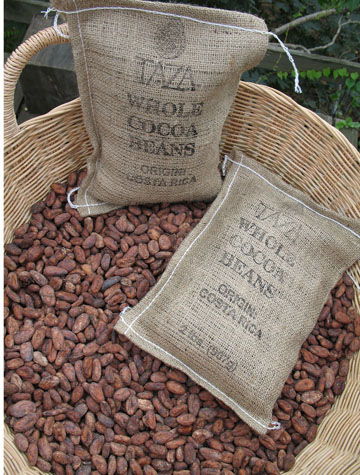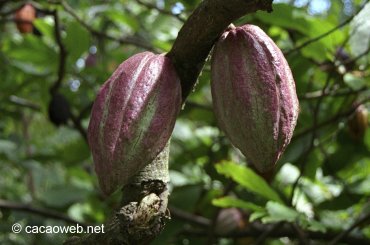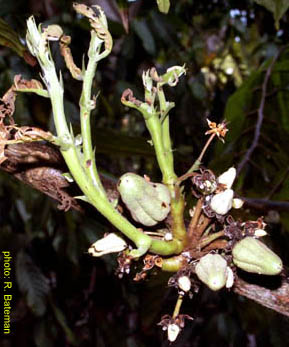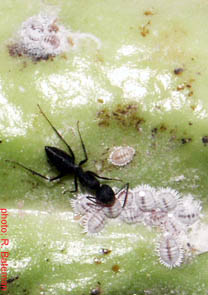Nature's Manufacturer of the "Food of the Gods!"
Feeling Used
The cacao tree is the master of using other organisms for its benefit. It has developed specific and very effective adaptations that allow it to thrive in its environment, most of which involve taking advantage of its neighbors. As mentioned on the Habitat page, cacao trees live under the shade of taller rainforest trees. Theobroma cacao uses this shade to protect its very delicate seeds from sunburn along with wind protection.
The tree rewards the midges by producing cherelles, tiny pods that die before they can grow. These immature pods rot and provide the perfect home for its tiny pollinators. For more information about the cacao's pollination, visit http://gears.tucson.ars.ag.gov/book/chap5/cacao.html or see the Reproduction page.
|
Another important interaction of
the cacao tree involves its
adaptation for brightly colored
pods. These multicolored seed
encasements, along with a
delicious fleshy pulp inside,
attract the attention of
monkeys, squirrels and
some birds. The tree relies on
animals to pick its pods and
carry them off for seed
dispersal. The bitter taste of
the seeds prevents them from
being eaten and allows for the
perfect placement when they are
dropped yards away from the
tree. |
Although Theobroma cacao is well adapted to exploit its neighbors, it is not exempt from being taken advantage of. There are numerous insects and fungi that infect this tropical tree's roots, leaves and pods. Many caterpillar and larvae species munch on the leaves, while other insects take up residence in rotting pods, along with the midges. Mosquitos, for example, often gather inside the moist, sweet pod in swarms to breed. For more information about mosquito reproduction visit
http://bioweb.uwlax.edu/bio203/s2008/otto_lau2/.
Crinipellis perniciosa
, a fungus that causes witches' broom disease is frequently found on the cacao tree since it is specific to the genus Theobroma. Other fungal diseases include Moniliophthora roreri (Frosty Pod Rot) which has very small, powdery spores and a root disease called Ceratocystis fimbriata. On the other hand, the tree does have a mutualistic relationship with other fungi (mychorrizae) like most plants throughout the world. The fungi receive nutrition from the plant's photosynthesis, while the tree uses the fungi for increased absorption of nutrients.Other insects can also harm the cacao tree. Helopeltis bergrath and Sahlbergella singularis use extensions of the mouth to suck out nutrients from the tree.
|
A particularly interesting insect that can be beneficial to Theobroma cacao is the black ant, Dolichoderus thoracicus. This ant is a fascinating organism that actually breed mealy bugs (Cataenococcus hispidus). These ants use the waste materials from the mealy bugs, called honeydew, as a food source and will protect them from any predators they can. In turn, the mealy bugs get obvious protection and a ready food source from the cacao tree. So how does this relationship benefit the tree? The presence of the black ants reduces the number of other insects that are harmful to the tree along with reducing the instance of black pod disease. As for the mealy bugs, they have no harmful effects on the tree. For more information about the black ant-mealy bug relationship visit www.oardc.ohio-state.edu/cocoa/ants.htm. |
Click here to learn about cacao's classification!
Copyright © 2007, Design by: Sunlight webdesign




